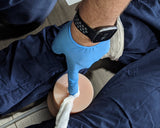STOP THE BLEED: Controlling Life Threatening External Bleeding

This article will review the step by step process of controlling major external bleeding. We reference the most up to date STOP THE BLEED and TCCC guidelines for this process (see references below for more in depth knowledge).
Wound packing and pressure dressing:







Tourniquet Placement and application:
WOUND PACKING MATERIAL

There are a number of options to choose from when selecting wound packing material for life threatening bleeding.
A packing gauze impregnated with a hemostatic agent is the ideal option as well as the most expensive. Some examples include Quikclot and ChitoSAM. The products assist in creating a clot in conjunction with pressure when applied directly to the source of bleeding.
If a hemostatic gauze is not available the next best option is compressed krinkle gauze. This is vacuum packing gauze that is specially Z-Folded and sterile to provide a sufficient amount of packing material to control bleeding with direct pressure when packing a wound. This could be replaced by roller gauze although these products and generally not sterile (not of large consequence for this purpose) and will not be as much material compared to the compressed krinkle gauze so multiple rolls may be required.
If no first aid equipment is available a wound can be packed with cloth (ideally cotton) to assist in controlling bleeding in conjunction with direct pressure, this is the least ideal as it can be difficult to pack a wound with clothing and the clothing will not be clean or sterile but in the absence of first aid supplies this can assist in controlling life threatening bleeding.
PRESSURE DRESSING

To cover the life threatening bleeding and maintain pressure to control bleeding a pressure dressing can be used in addition to manual pressure from the responder.
A commercial pressure dressing such as the High strength pressure dressing (Israeli Type) allows for a quickly deployed and applied solution.
If a commercial pressure dressing is not available an improvised pressure dressing can be created by applying an abdominal pad to the wound and wrapping with an Elastic (Tensor) Wrap. As you apply the elastic wrap you can twist it over the source of bleeding to increase the pressure directly over the wound.
In the absence of the above items you can use a triangular bandage or clothing to wrap and tie the bandage in place, create your know directly over the wound to assist in directing the pressure on the source of bleeding.
TOURNIQUETS

A tourniquet is a device that is applied to extremities to completely shut down any blood flow to the limb below it.
The current medical evidence suggest that a windlass style tourniquet is the most successful at controlling life threatening bleeding. Some reputable brand names of Windlass tourniquets include: Recon Medical Gen 4 Tourniquet, CAT Gen 7 Tourniquet, Tactical Medical Solutions SOF Tourniquet 2021 Generation. Be aware of knock off tourniquets often sold on amazon or other non-medical sites as they may fail during use.
Tourniquets should be applied to life threatening bleeding if the situation is dangerous or a mass casualty incident is occurring in which time cannot be spent applying pressure with wound packing and a pressure dressing. They can also be used if the pressure dressing at the site of bleeding is not working to control blood loss.
The tourniquet should be applied at least 2-3 inches above the source of bleeding (do not place on joint go above joint if necessary).
When applying the tourniquet make sure the strap is tight before turning the windlass.
Turn the windlass until bleeding is no longer occurring and secure in securement device on tourniquet.
Once the tourniquet is applied record the time of application on the tourniquet and/or on the patients forehead with a marker.
Always monitor the limb while waiting for EMS 9-1-1 to ensure the tourniquet has not loosened or failed and tighten as needed. If bleeding is not well controlled with 1 tourniquet a second tourniquet can be applied above the first.
Tourniquets can be applied in a pre-hospital environment for up to 2 hours before lasting damage is present to the limb. In a wilderness or remote environment attempt to create a pressure dressing at the site of bleeding and consider releasing the tourniquet if the pressure dressing can now control the bleeding. If a tourniquet has been in place for greater than 6 hours leave it in place and do not remove it.
BUILDING YOUR BLEEDING CONTROL KIT
We have curated a collection of all the products and resources available to build your own or purchase a pre-built life threatening bleed kit at the link below:
Bleeding Control First Aid Supplies
RESOURCES:
*This article is meant for informational purposes only and does not replace reputable training in these skills. To gain further experience and practice in these skills consider taking a First Aid or First Responder course from the Canadian Red Cross and/or a STOP THE BLEED course near you.*

